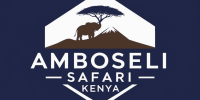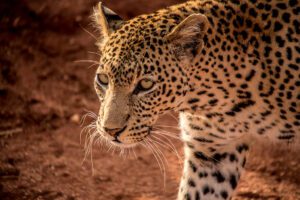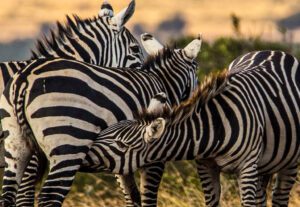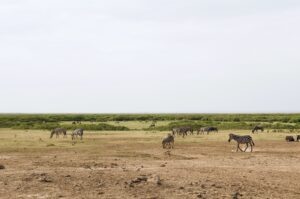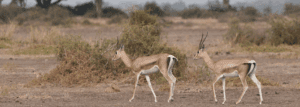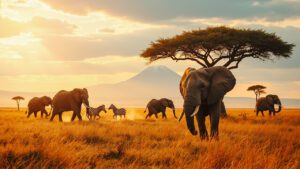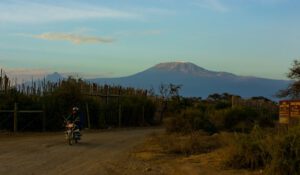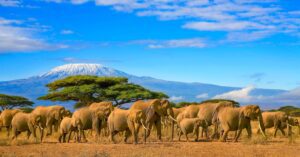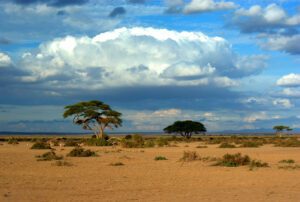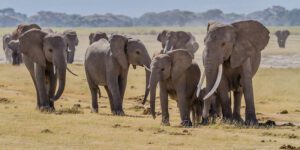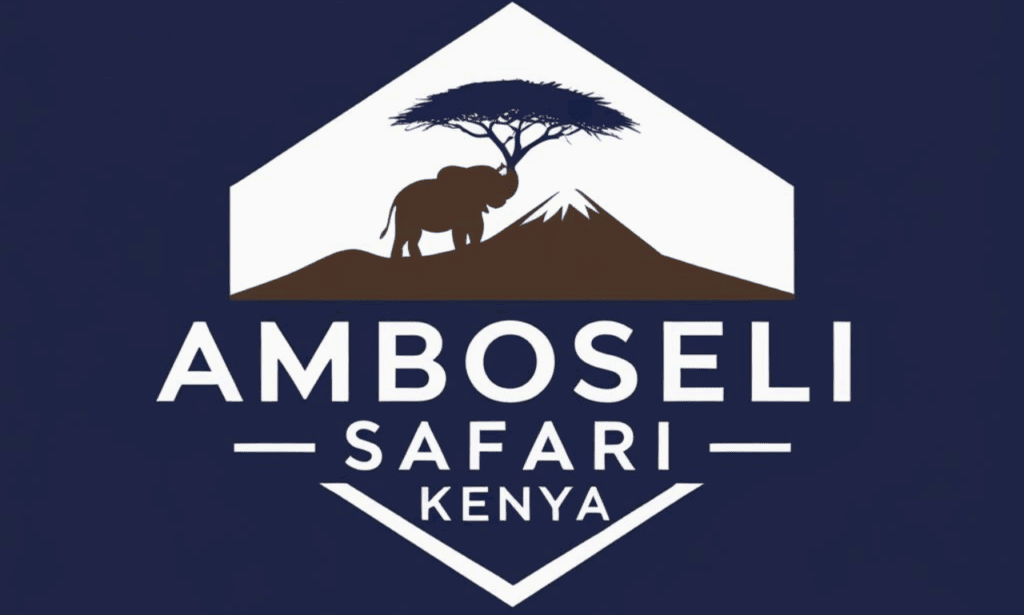What is a game drive, and how is it conducted in Amboseli National Park?
A game drive is essentially a safari adventure where visitors use safari vehicles to explore a wildlife park and observe animals in their natural habitat. In the case of Amboseli National Park in Kenya, this unique safari experience is particularly special because the park is known for its breathtaking landscapes and abundant wildlife. A game drive in Amboseli typically involves a licensed safari guide who drives guests around the park in a safari jeep, designed to handle rough terrain. The vehicle usually has an open roof or large windows to maximize visibility and allow visitors to take great photographs.
The drive is conducted on designated roads within the park to minimize disturbance to the environment. Guides help guests spot animals by knowing their usual behaviors, habitats, and preferred times to emerge, like elephants gathering around waterholes or lions seeking shade after a hunt. Visitors are encouraged to stay inside the vehicle at all times for safety and to respect wildlife, especially during night game drives when animals are more active.
The highlight of game drives in Amboseli is the stunning backdrop of Mount Kilimanjaro, the tallest mountain in Africa. Imagine watching a large herd of elephants crossing a dusty plain with Kilimanjaro’s snowy peaks in the background, it’s a must-see for anyone who visits the park. Drives often happen early in the morning to catch active wildlife or late in the afternoon to avoid the midday heat.

What wildlife species can be spotted during an Amboseli Game Drive?
Amboseli is sometimes nicknamed the “Land of Giants” because of its large elephant herds, making them the stars of any safari game drive. Visitors can spot hundreds of elephants roaming the open plains, often traveling in large family groups. These majestic creatures are famous for being generally less shy of humans, which makes it easier to see them up close. It’s not uncommon to see elephants bathing in mud or drinking from waterholes during the late afternoons or evenings.
Besides elephants, Amboseli is home to plenty of other animals. Lions, often called the “kings of the jungle,” are present in the park too. They can sometimes be found resting under trees or stalking prey like wildebeests or zebras. Speaking of zebras and wildebeests, they are plentiful in Amboseli and can often be seen grazing in the savannah grasslands. Giraffes, with their long necks, also wander across the plains, pulling leaves from tall trees, adding to the unique safari experience.
Smaller animals like warthogs (often remembered from movies like The Lion King), hyenas, and jackals can also be spotted. Birds are another big attraction, Amboseli is home to over 400 bird species, including flamingos, ostriches, and colorful kingfishers. Hippos can also be seen in marshy areas of the park, and if you’re lucky, you might catch a cheetah sprinting across the plains or a rare sighting of the shy leopard during your safari jeep adventure.
What is the best time of year to visit Amboseli for a game drive?
The best time to visit Amboseli National Park for a safari experience is during the dry seasons in Kenya, which are between June and October and from January to February. During these months, there is less rainfall, making the weather more predictable and the park easier to navigate. Additionally, in the dry season, animals tend to gather around water sources, like the park’s swamps and marshes, making them easier to spot. For instance, you might see large herds of elephants congregating near waterholes to drink and cool down, particularly during evening game drives.
The rainy seasons (March to May and November to December) are less ideal because heavy rain can make roads muddy or difficult for safari vehicles to drive through. However, the advantage of visiting during the wet season is that the landscapes are lush and green, providing a beautiful backdrop for photographs. Bird enthusiasts might particularly enjoy the wet season, as migratory birds visit during this time, creating unique opportunities for wildlife observation.
If you’re eager to see Mount Kilimanjaro clearly, the early mornings during the dry season are usually the best. The clouds tend to lift at sunrise, offering stunning, unobstructed views of the mountain. Whether you choose the dry season or the wet season, Amboseli always has something to offer, just plan accordingly with the help of tour operators or guides to make the most of your safari game drive.
What are the unique features of Amboseli National Park compared to other parks in Kenya?
Amboseli National Park is one of Kenya’s most famous wildlife reserves, distinguished by several unique features that enhance the safari experience. One of its most iconic attributes is the breathtaking views of Mount Kilimanjaro, the tallest mountain in Africa. While the mountain itself lies in Tanzania, Amboseli provides a stunning backdrop for wildlife photography, as Kilimanjaro’s snow-capped peak looms magnificently over the savannah grasslands. The sight of elephants roaming across the plains with the mountain behind them is one of the most recognizable images of African wildlife during safari game drives.
Another remarkable aspect of Amboseli is its large population of elephants, making it one of the best places in the world for game viewing. The elephants here are renowned for their incredible size and are habituated to human presence, allowing visitors to observe them closely while respecting their natural behavior. This unique opportunity is often a highlight for safari tourists looking to encounter these majestic creatures.
Amboseli is also known for its wetlands and swampy environments, which are sustained by underground water sources from Mount Kilimanjaro. These swamps serve as an oasis in an otherwise dry region, attracting diverse wildlife even during drier seasons. During evening game drives, you’ll find elephants cooling off in the water, along with hippos, crocodiles, and a variety of birds, making for a captivating wildlife sanctuary.
Lastly, the Maasai people, who reside near the park, have a profound cultural connection to the land. Visitors often get the chance to interact with Maasai communities, learning about their traditions, dance, and ceremonies, which adds to the overall safari experience.
To sum up, Amboseli stands out due to its proximity to Mount Kilimanjaro, its thriving elephant herds, unique swamp ecosystems, and rich Maasai culture, making it a must-visit destination for those looking to explore Amboseli National Park.
How long does a typical game drive in Amboseli last?
A typical safari game drive in Amboseli National Park generally lasts around 2 to 3 hours. However, the duration can vary depending on the preferences of the visitors, the time of day, and whether it’s a private drive, a group safari, or a self-drive. These game drives can take place in the early morning, afternoon, or even during sunset, allowing guests to choose shorter or extended excursions based on their schedule and interests.
Morning drives are particularly popular and can start as early as 6:00 AM. These drives last about three hours and are ideal for spotting a variety of animals because wildlife is often more active in the cooler hours of the morning. You’ll likely see large elephant herds, lions, and birds during these hours, many of them out feeding or drinking at waterholes.
Meanwhile, afternoon drives (roughly between 3:00 PM and 6:00 PM) are another option. These drives often coincide with the animals’ afternoon activities, such as elephants cooling off by the swamps or predators preparing for their evening hunts. The golden light during the late afternoon also makes for spectacular photography, showcasing the landscape and animals in warm and dramatic tones.
For travelers who want a condensed experience, some safari jeep drives go for just 1.5 to 2 hours, ideal if you’re on a tight schedule but still want to experience Amboseli. Alternatively, for enthusiasts who crave a deeper dive, full-day game drives lasting anywhere from 6 to 8 hours are also an option. These cover multiple areas of the park and allow you to spot a wide variety of animals and landscapes.
In summary, most game drives last between 2 to 3 hours, but there’s flexibility depending on your time and needs. Whether it’s a quick drive or a full-day adventure, every moment spent in this park is an unforgettable safari experience.
What are the iconic attractions in Amboseli apart from wildlife, such as Mount Kilimanjaro views?
Apart from its incredible wildlife, Amboseli National Park is famous for its jaw-dropping scenery and other iconic attractions. At the top of the list is the view of Mount Kilimanjaro. Even though the mountain is located across the border in Tanzania, Amboseli offers the most quintessential view of its towering peak. Its snow-covered summit provides a surreal backdrop to the vast savannahs. Many visitors come to Amboseli specifically for safari experiences, photographing the animals, especially elephants, with the dramatic Kilimanjaro skyline behind them. However, it’s worth noting that clear views are best early in the morning before clouds cover the peak.
Another notable attraction is Amboseli’s unique ecosystem of swamps and wetlands. The park is located in an otherwise arid region of Kenya, but the swamps, fed by underground springs from Kilimanjaro’s glaciers, create lush green environments teeming with life. For example, places like Longinye Swamp and Enkongo Narok Swamp are mesmerizing spots to watch animals like elephants wading through the water, hippos wallowing in the mud, and a variety of water birds such as pelicans, herons, and egrets during game viewing drives.
In addition to its natural landscapes, Amboseli offers cultural experiences with the local Maasai people. Visitors can take a short trip to neighboring Maasai villages to learn about their rich traditions, including their vibrant beadwork, songs, dances, and ceremonies. Interacting with the Maasai allows tourists to connect with the region’s history and gain a deeper understanding of the people who live harmoniously alongside the wildlife, enhancing their overall safari experience.
For those interested in history, you can also visit Observation Hill. This elevated spot provides panoramic views of the park, the swamps, and the sprawling plains. It’s an excellent location to see the scale of Amboseli’s vast landscapes, with Mount Kilimanjaro in the background. The combination of thrilling wildlife encounters, iconic scenery, and cultural richness makes Amboseli much more than just another safari destination, it’s an unforgettable experience.
Are guided game drives available, or can visitors opt for self-drive experiences in Amboseli?
Yes, Amboseli National Park offers both guided game drives and self-drive experiences, so visitors can choose what suits them best.
A guided game drive means you will be accompanied by a professional guide or ranger, normally in a safari tour vehicle provided by a tour company or lodge. Guides are highly knowledgeable about the park, its wildlife, and the best places to spot animals like elephants, lions, and cheetahs. They also know animal behaviors and can take you to specific areas depending on what you want to see. For example, if the guide knows of a pride of lions hunting near a watering hole, they can take you there. Guided drives are especially useful for first-time visitors or those who want to learn more about the wildlife and the park itself.
A self-drive experience means you’ll use your own vehicle (or a rented one) to explore the park. This gives you more flexibility, you can stop wherever and whenever you like, within park rules, of course. However, self-driving requires a sturdy vehicle, like a 4×4, because the roads inside the park can be rough and challenging. You also need to be confident in navigating without a guide, which can be tricky if you aren’t familiar with where animals might be located. For example, you could drive for hours and miss key wildlife hotspots or get stuck in muddy conditions without help.
For most people, guided drives provide a richer experience since the guides can answer questions, share fun facts about the animals and plants, and take the stress out of driving. Self-drives, on the other hand, are more adventurous and allow a sense of independence. Both options are great, depending on what you’re looking for!
What is the best time of day for a game drive in Amboseli, morning, afternoon, or evening?
The best time for a game drive in Amboseli is early morning or late afternoon. These times are when the animals are most active, and the heat of the day is less intense.
During the early morning (from around 6:30 a.m. to 9:30 a.m.), the park is cooler, and animals are often out and about looking for food or water after the night. This is a great time to spot predators, like lions, as they might still be hunting or lounging from an overnight kill. Birds are also very active during the morning, and the soft morning light makes the scenery, especially Mount Kilimanjaro, extra stunning. For photographers, the early morning provides fantastic lighting for capturing animals and the breathtaking landscape.
The late afternoon (around 4 p.m. to 6 p.m.) is another excellent time because animals often come out to cool down, drink water, or graze as the temperatures start to drop. Herds of elephants, a highlight of Amboseli, are frequently seen heading to waterholes during this time. As the day moves toward sunset, the golden hour creates a magical atmosphere, making it ideal for both wildlife sightings and photography.
Game drives during the middle of the day are less ideal because Amboseli can get very hot, and most animals rest or hide in the shade to avoid the heat. For example, a cheetah might be sleeping under a tree, and it can be harder to spot wildlife during this time.
In summary, morning and late afternoon game drives offer not only better wildlife sightings but also enjoyable weather and fantastic natural lighting. Plan accordingly!
What preparations or essentials should you bring for a game drive in Amboseli?
To make the most of your game drive in Amboseli National Park, it’s important to be prepared with some essential items. Here’s an easy-to-follow checklist:
- Clothing and Sun Protection: Wear comfortable, neutral-colored clothing to blend in with the environment. Bright colors can sometimes scare away animals. Bring a wide-brim hat, sunglasses, and sunscreen because Amboseli is sunny and warm, especially around midday.
- Binoculars and Cameras: Bring binoculars to help you spot animals that are far away, like a lion lounging in the grass or elephants moving in herds. A camera is a must for capturing the stunning wildlife and landscapes, just don’t forget extra memory cards and batteries! If possible, use a zoom lens to get close-up photos of animals without getting in their way.
- Water and Snacks: It’s essential to stay hydrated, especially since the park can get hot. Bring enough drinking water for everyone in your group. Light snacks, like granola bars or fruit, are handy for long drives, but be mindful not to litter or feed the animals.
- Insect Repellent: Mosquitoes and other biting insects can sometimes be a problem, especially in the early morning or late afternoon. A good insect repellent will help keep bites at bay.
- Park Map and Guidebook (if self-driving): If you’re doing a self-drive, a good map or guidebook is essential to help navigate the vast park and locate common wildlife habitats or waterholes.
- Comfortable Footwear and Layers: While you’ll mostly stay in the vehicle, comfortable shoes are important in case you need to step out. Additionally, bring layers, like a light jacket or sweater, as mornings can be chilly before the sun fully rises.
- Patience and Respect: Finally, bring your patience and respect for wildlife. Animals don’t always appear immediately, so you may need to wait quietly to spot them. Always follow park rules, such as staying in your vehicle, keeping a safe distance, and not making loud noises.
With these preparations in place, you’ll be ready for an enjoyable and unforgettable game drive in Amboseli National Park!
Are there any cultural or local community experiences connected to game drives in the Amboseli region?
Yes, there are several rich cultural and local community experiences connected to game drives in the Amboseli region. Amboseli is not only known for its breathtaking wildlife and landscapes but also for its proximity to the Maasai people, who have lived in the region for centuries. The Maasai are a semi-nomadic ethnic group known for their vibrant culture, traditional way of life, and deep connection to the land and wildlife. Visitors to Amboseli have the unique opportunity to engage with these communities and understand their traditions.
One popular cultural experience is visiting a Maasai village, often called a “boma.” Here, you can learn about the Maasai’s daily life, including their traditional clothing, food, and homes. The Maasai are known for their bright red shukas (robes) and intricate beadwork. You’ll often see women creating beautiful, colorful jewelry that’s sold to visitors as a source of income. During these visits, the Maasai might perform traditional dances and songs, like the famous “jumping dance,” where men leap high into the air in a display of strength and vitality.
Another aspect of the experience is learning about the Maasai’s relationship with wildlife. They coexist with animals that tourists come to see, like elephants and lions, and have knowledge about the land that’s passed down through generations. For instance, you may hear stories of how they protect their livestock from predators or navigate the terrain by observing nature’s signals.
By engaging in these cultural experiences during your game drive trip, you not only support local communities through tourism but also gain a deeper appreciation for the human-wildlife balance in the region. It’s a chance to connect with the people who have helped preserve Amboseli’s ecosystem.
What are the accommodation options available around Amboseli for visitors on game drives?
Visitors to Amboseli National Park have a variety of accommodation options to suit different budgets and preferences, ranging from luxury lodges to budget-friendly camping sites. These options are designed to immerse visitors in the stunning natural beauty of the park, with many offering incredible views of wildlife and Mount Kilimanjaro.
For those looking for a luxurious experience, Amboseli has several high-end lodges and tented camps that provide all the comforts you’d expect, such as spacious rooms, gourmet meals, and even swimming pools. Examples include Amboseli Serena Safari Lodge and Tawi Lodge. Many of these accommodations are designed to blend into the natural environment while offering breathtaking views of Amboseli’s iconic landscapes, such as elephants roaming with Mount Kilimanjaro as a backdrop.
Mid-range accommodations are also available for travelers seeking comfort at a more affordable price. These options often include cozy cottages, tents with en-suite facilities, and friendly staff who can organize game drives or cultural tours. Places like Satao Elerai and Kibo Safari Camp strike a balance between affordability and a touch of luxury, making them attractive to couples and families.
For budget travelers or those seeking a more adventurous experience, there are campsites in and around Amboseli where you can sleep under the stars surrounded by nature. Community-run campsites, like Kimana Community Camp, not only let you save money but also support local communities. However, camping often requires you to bring your own gear or rent it from local suppliers.
No matter where you stay, most lodges, camps, and tented options provide guided game drives within the park or cultural excursions with local Maasai communities. Make sure to book your accommodations in advance, especially during peak seasons, to secure your ideal experience!
Are there any conservation efforts or environmental considerations during game drives in Amboseli?
Yes, conservation and environmental considerations are a crucial part of game drives in Amboseli National Park. The park faces challenges such as habitat loss, human-wildlife conflicts, and the impact of climate change, so conservation efforts are especially important to ensure the area’s natural beauty and biodiversity are protected for future generations.
One key conservation effort in Amboseli involves protecting its iconic resident elephants. Amboseli is home to one of Africa’s most well-studied elephant populations, thanks to organizations like the Amboseli Trust for Elephants (ATE). ATE works to study and safeguard elephant families, mitigating human-elephant conflicts and promoting coexistence. When you go on a safari jeep adventure, guide companies are often aware of how to observe elephants respectfully, ensuring minimum stress on the animals.
There’s also a strong focus on sustainable tourism. For instance, many lodges and camps in the Amboseli area have adopted eco-friendly practices, such as using solar energy, implementing waste management systems, and sourcing water sustainably. By staying at these eco-conscious accommodations, visitors directly contribute to reducing the environmental footprint of tourism in the park.
Additionally, there are strict park rules to ensure game drives are low-impact. Vehicles must stick to designated trails to prevent damage to the fragile ecosystem. Off-road driving, littering, and disturbing animals by getting too close are prohibited. Visitors are encouraged to observe wildlife quietly and respect their natural habitats.
Community involvement plays a major role in conservation as well. Many local Maasai communities collaborate with conservation organizations to create wildlife corridors and protect natural resources. By participating in cultural experiences or buying souvenirs from these communities, you directly support their efforts to live sustainably alongside wildlife.
In summary, conservation in Amboseli is a team effort involving researchers, local communities, park authorities, and tourists. By following guidelines and choosing eco-conscious options, your safari experience can be part of protecting Amboseli’s incredible environment!
